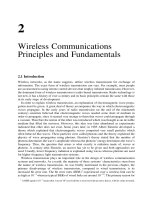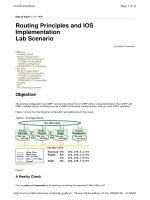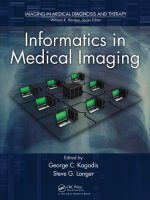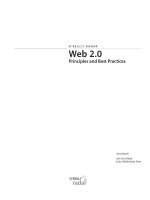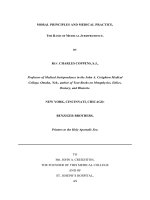principles and advanced methods in medical imaging and image analysis (wsp, 2008)
Bạn đang xem bản rút gọn của tài liệu. Xem và tải ngay bản đầy đủ của tài liệu tại đây (36.59 MB, 868 trang )
PRINCIPLES AND ADVANCED METHODS IN
MEDICAL IMAGING AND IMAGE ANALYSIS
This page intentionally left blankThis page intentionally left blank
NEW JERSEY • LONDON • SINGAPORE • BEIJING • SHANGHAI • HONG KONG • TAIPEI • CHENNAI
World Scientic
PRINCIPLES AND ADVANCED METHODS IN
MEDICAL IMAGING AND IMAGE ANALYSIS
ATAM P DHAWAN
New Jersey Institute of Technology, USA
H K HUANG
University of Southern California, USA
DAE-SHIK KIM
Boston University, USA
British Library Cataloguing-in-Publication Data
A catalogue record for this book is available from the British Library.
For photocopying of material in this volume, please pay a copying fee through the Copyright
Clearance Center, Inc., 222 Rosewood Drive, Danvers, MA 01923, USA. In this case permission to
photocopy is not required from the publisher.
ISBN-13 978-981-270-534-1
ISBN-10 981-270-534-1
ISBN-13 978-981-270-535-8 (pbk)
ISBN-10 981-270-535-X (pbk)
Typeset by Stallion Press
Email:
All rights reserved. This book, or parts thereof, may not be reproduced in any form or by any means,
electronic or mechanical, including photocopying, recording or any information storage and retrieval
system now known or to be invented, without written permission from the Publisher.
Copyright © 2008 by World Scientific Publishing Co. Pte. Ltd.
Published by
World Scientific Publishing Co. Pte. Ltd.
5 Toh Tuck Link, Singapore 596224
USA office: 27 Warren Street, Suite 401-402, Hackensack, NJ 07601
UK office: 57 Shelton Street, Covent Garden, London WC2H 9HE
Printed in Singapore.
PRINCIPLES AND ADVANCED METHODS IN MEDICAL IMAGING AND
IMAGE ANALYSIS
ChingTing - Principles and Adv Methods.pmd 6/18/2008, 9:12 AM1
January 23, 2008 11:18 WSPC/SPI-B540:Principles and Recent Advances fm
To
My wife, Nilam,
for her support and patience;
and my sons, Anirudh and Akshay,
for their quest for learning.
(Atam P Dhawan)
To
My wife, Fong,
for her support;
and my daughter, Cammy; and my son, Tilden,
for their young wisdom.
(HK Huang)
To
My daughter, Zeno,
for her curiosity
(Dae-Shik Kim)
v
January 23, 2008 11:18 WSPC/SPI-B540:Principles and Recent Advances fm
This page intentionally left blankThis page intentionally left blank
January 23, 2008 11:18 WSPC/SPI-B540:Principles and Recent Advances fm
Preface and Acknowledgments
We are pleased to bring “Principles and Advanced Methods in
Medical Imaging and Image Analysis”, a volume of contributory
chapters, to the scientific community. The book is a compilation
of carefully crafted chapters written by leading researchers in the
field of medical imaging they have put in a great deal of effort
in contributing the various chapters. This book can be used as
a research reference or a text book for graduate level courses in
biomedical engineering and medical sciences.
The book is a unique combination of chapters describing the
principles as well as state-of-the-art advanced methods in medical
imaging and image analysis for selected applications. Though com-
puterized medical imaging has a very wide spectrum of applications
in diagnostic radiology and medical research, we have selected a
subset of important imaging modalities with specific applications
that are significant in medical sciences and clinical practice. The
topics covered in the chapters have been developed with a natural
progression of understanding, keeping in mind future technological
advances that are expected to have a major impact in clinical prac-
tice and the understanding of complex pathologies. We hope that
this book will provide a unique learning experience from theoreti-
cal concepts to advanced methods and applications to researchers,
clinicians and students.
vii
January 23, 2008 11:18 WSPC/SPI-B540:Principles and Recent Advances fm
viii
Preface and Acknowledgments
We are very grateful to our contributors who are internationally
renowned experts and experienced researchers in their respective
fields within the wide spectrum of medical imaging and comput-
erized medical image analysis. We also gracefully acknowledge the
support provided by the editorial board and staff members of World
Scientific Publishing. Special thanks to Ms CT Ang for her guidance
and patience in preparing this book.
We hope that readers will find this book useful in providing a
concise version of important principles, advances, and applications
in medical imaging and image analysis.
Atam P Dhawan
HK Huang
Dae-Shik Kim
January 23, 2008 11:18 WSPC/SPI-B540:Principles and Recent Advances fm
Contributors
Walter J Akers, PhD
Staff Scientist, Optical Radiology Laboratory
Department of Radiology
Washington University School of Medicine
University of Washington at St Louis
Elsa Angelini, PhD
Ecole Nationale Supérieure des
Télécommunications
Paris, France
Leonard Berliner, MD
Department of Radiology
New York Methodist Hospital, NY
Sharon Bloch, PhD
Optical Radiology Laboratory, Department of Radiology
Washington University School of Medicine
University of Washington at St Louis
Christos Davatzikos, PhD
Director, Section of Biomedical Image Analysis
Associate Professor, Department of Radiology
University of Pennsylvania
ix
January 23, 2008 11:18 WSPC/SPI-B540:Principles and Recent Advances fm
x
Contributors
Mathieu De Craene, PhD
Computational Imaging Lab
Department of Information
and Communication Technologies
Universitat Pompeu Fabra, Barcelona
Atam P Dhawan, PhD
Professor, Department of Electrical
and Computer Engineering
Professor, Department of Biomedical Engineering
New Jersey Institute of Technology
Qi Duan, PhD
Department of Biomedical Engineering
Columbia University
Alejandro F Frangi, PhD
Computational Imaging Lab
Department of Information
and Communication Technologies
Universitat Pompeu Fabra, Barcelona
Shunichi Homma, MD
Margaret Millikin Hatch Professor
Department of Medicine
Columbia University
HK Huang, DSc
Professor and Director, Imaging Informatics Division
Department of Radiology, Keck School of Medicine
Department of Biomedical Engineering
Viterbi School of Engineering
University of Southern California
Dae-Shik Kim, PhD
Director, Center for Biomedical Imaging
Associate Professor, Anatomy and Neurobiology
Boston University School of Medicine
January 23, 2008 11:18 WSPC/SPI-B540:Principles and Recent Advances fm
Contributors
xi
Elisa E Konofagou, PhD
Assistant Professor
Department of Biomedical Engineering
Columbia University
Andrew Laine, PhD
Professor
Department of Biomedical Engineering
Columbia University
Angela R Laird, PhD
Assistant Professor, Department of Radiology
University of Texas Health Sciences Center
San Antonio
Maria YY Law, PhD
Associate Professor
Department of Health Technology and Informatics
The Hong Kong Polytechnic University
Heinz U Lemke, PhD
Research Professor, Department of Radiology
University of Southern California
Los Angeles, CA
Guang Li, PhD
Medical Physicist, Radiation Oncology Branch
National Cancer Institute,
NIH, Bethesda, Maryland
Brent J Liu, PhD
Assistant Professor and Deputy Director of Informatics
Department of Radiology, Keck School of Medicine
Department of Biomedical Engineering
Viterbi School of Engineering
University of Southern California
January 23, 2008 11:18 WSPC/SPI-B540:Principles and Recent Advances fm
xii
Contributors
Tianming Liu, PhD
Center for Bioinformatics
Harvard Medical School
Department of Radiology
Brigham and Women’s Hospital, MA
Sachin Patwardhan, PhD
Research Scientist, Department of Radiology
Mallinckrodt Institute of Radiology
University of Washington, St Louis
Xiaochuan Pan, PhD
Professor
Department of Radiology
Cancer Research Center
The University of Chicago
Itamar Ronen, PhD
Assistant Professor
Center for Biomedical Imaging
Department of Anatomy and Neurobiology
Boston University School of Medicine
Yulin Song, PhD
Associate Professor
Department of Radiology
Memorial Sloan-Kettering Cancer Center
New Jersey
Song Wang, PhD
Department of Electrical
and Computer Engineering
New Jersey Institute of Technology
Pat Zanzonico, PhD
Molecular Pharmacology and Chemistry
Memorial Sloan-Kettering Cancer Center
New York
January 23, 2008 11:18 WSPC/SPI-B540:Principles and Recent Advances fm
Contributors
xiii
Zheng Zhou, PhD
Manager
Imaging Processing and Informatics Lab
Department of Radiology
University of Southern California
Xiang Sean Zhou, PhD
Senior Staff Scientist, Program Manager
Computer Aided Diagnosis and Therapy Solutions
Siemens Medical Solutions, Inc., Malvern PA
Lionel Zuckier, MD
Head, Nuclear Medicine
Department of Radiology
New Jersey University for Medicine and Dentistry
January 23, 2008 11:18 WSPC/SPI-B540:Principles and Recent Advances fm
This page intentionally left blankThis page intentionally left blank
January 23, 2008 11:18 WSPC/SPI-B540:Principles and Recent Advances fm
Contents
Preface and Acknowledgments vii
Contributors ix
1. Introduction to Medical Imaging and Image
Analysis: A Multidisciplinary Paradigm 1
Atam P Dhawan, HK Huang and Dae-Shik Kim
Part I. Principles of Medical Imaging and Image
Analysis
2. Medical Imaging and Image Formation 9
Atam P Dhawan
3. Principles of X-ray Anatomical Imaging
Modalities 29
Brent J Liu and HK Huang
4. Principles of Nuclear Medicine Imaging
Modalities 63
Lionel S Zuckier
5. Principles of Magnetic Resonance Imaging 99
Itamar Ronen and Dae-Shik Kim
6. Principles of Ultrasound Imaging Modalities 129
Elisa Konofagou
7. Principles of Image Reconstruction Methods 151
Atam P Dhawan
8. Principles of Image Processing Methods 173
Atam P Dhawan
xv
January 23, 2008 11:18 WSPC/SPI-B540:Principles and Recent Advances fm
xvi
Contents
9. Image Segmentation and Feature Extraction 197
Atam P Dhawan
10. Clustering and Pattern Classification 229
Atam P Dhawan and Shuangshuang Dai
Part II. Recent Advances in Medical Imaging and
Image Analysis
11. Recent Advances in Functional Magnetic
Resonance Imaging 267
Dae-Shik Kim
12. Recent Advances in Diffusion Magnetic
Resonance Imaging 289
Dae-Shik Kim and Itamar Ronen
13. Fluorescence Molecular Imaging: Microscopic to
Macroscopic 311
Sachin V Patwardhan, Walter J Akers and
Sharon Bloch
14. Tracking Endocardium Using Optical Flow
Along Iso-Value Curve 337
Qi Duan, Elsa Angelini, Shunichi Homma and
Andrew Laine
15. Some Recent Developments in Reconstruction
Algorithms for Tomographic Imaging 361
Chien-Min Kao, Emil Y Sidky, Patrick La Rivière
and Xiaochuan Pan
16. Shape-Based Reconstruction from Nevoscope
Optical Images of Skin Lesions 393
Song Wang and Atam P Dhawan
17. Multimodality Image Registration and Fusion . . . 413
Pat Zanzonico
18. Wavelet Transform and Its Applications in
Medical Image Analysis 437
Atam P Dhawan
January 23, 2008 11:18 WSPC/SPI-B540:Principles and Recent Advances fm
Contents
xvii
19. Multiclass Classification for Tissue
Characterization 455
Atam P Dhawan
20. From Pairwise Medical Image Registration to
Populational Computational Atlases 481
M De Craene and AF Frangi
21. Grid Methods for Large Scale Medical Image
Archiving and Analysis 517
HK Huang, Zheng Zhou and Brent Liu
22. Image-Assisted Knowledge Discovery
and Decision Support in Radiation
Therapy Planning 545
Brent J Liu
23. Lossless Digital Signature Embedding
Methods for Assuring 2D and 3D Medical
Image Integrity 573
Zheng Zhou, HK Huang and Brent J Liu
Part III. Medical Imaging Applications, Case Studies
and Future Trends
24. The Treatment of Superficial Tumors Using
Intensity Modulated Radiation Therapy and
Modulated Electron Radiation Therapy 599
Yulin Song and Maria Chan
25. Image Guidance in Radiation Therapy 635
Maria YY Law
26. Functional Brain Mapping and Activation
Likelihood Estimation Meta-Analysis 663
Angela R Laird, Jack L Lancaster and Peter T Fox
27. Dynamic Human Brain Mapping and Analysis:
From Statistical Atlases to Patient-Specific
Diagnosis and Analysis 677
Christos Davatzikos
January 23, 2008 11:18 WSPC/SPI-B540:Principles and Recent Advances fm
xviii
Contents
28. Diffusion Tensor Imaging Based Analysis
of Neurological Disorders 703
Tianming Liu and Stephen TC Wong
29. Intelligent Computer Aided Interpretation
in Echocardiography: Clinical Needs
and Recent Advances 725
Xiang Sean Zhou and Bogdan Georgescu
30. Current and Future Trends in Radiation
Therapy 745
Yulin Song and Guang Li
31. IT Architecture and Standards for a
Therapy Imaging and Model Management
System (TIMMS) 783
Heinz U Lemke and Leonard Berliner
32. Future Trends in Medical and Molecular
Imaging 829
Atam P Dhawan, HK Huang and Dae-Shik Kim
Index 845
January 22, 2008 12:2 WSPC/SPI-B540:Principles and Recent Advances ch01 FA
CHAPTER 1
Introduction to Medical Imaging
and Image Analysis:
A Multidisciplinary Paradigm
Atam P Dhawan, HK Huang and Dae-Shik Kim
Recent advances in medical imaging with significant contributions from
electrical and computer engineering, medical physics, chemistry, and
computer science have witnessed a revolutionary growth in diagnostic
radiology. Fast improvements in engineering and computing technolo-
gies have made it possible to acquire high-resolution multidimensional
images of complex organs to analyze structural and functional information
of human physiology for computer-assisted diagnosis, treatment evalua-
tion, and intervention. Through large databases of vast amount of infor-
mation such as standardized atlases of images, demographics, genomics,
etc. new knowledge about physiological processes and associated patholo-
gies is continuously being derived to improve our understanding of criti-
cal diseases for better diagnosis and management. This chapter provides
an introduction to this ongoing knowledge quest and the contents of the
book.
1.1 INTRODUCTION
In a general sense, medical imaging refers to the process involving
specialized instrumentation and techniques to create images or rel-
evant information about the internal biological structures and func-
tions of the body. Medical imaging is sometimes categorized, in a
wider sense, as a part of radiological sciences. This is particularly
1
January 22, 2008 12:2 WSPC/SPI-B540:Principles and Recent Advances ch01 FA
2
Atam P Dhawan, HK Huang and Dae-Shik Kim
relevant because of its most common applications in diagnostic radi-
ology. In clinical environment, medical images of a specific organ or
part of the body are obtained for clinical examination for the diag-
nosis of a disease or pathology. However, medical imaging tests are
also performed to obtain images and information to study anatom-
ical and functional structures for research purposes with normal as
well as pathological subjects. Such studies are very important to
understand the characteristic behavior of physiological processes in
human body to understand and detect the onset of a pathology. Such
an understanding is extremely important for early diagnosis as well
as developing a knowledge base to study the progression of a disease
associated with the physiological processes that deviate from their
normal counterparts. The significance of medical imaging paradigm
is its direct impact on the healthcare through diagnosis, treatment
evaluation, intervention and prognosis of a specific disease.
From a scientific point of view, medical imaging is highly multi-
disciplinary and interdisciplinary with a wide coverage of physical,
biological, engineering and medical sciences. The overall technology
requires direct involvement of expertise in physics, chemistry, biol-
ogy, mathematics, engineering, computer science and medicine so
that useful procedures and protocols for medical imaging tests with
appropriate instrumentation can be developed. The development
of a specific imaging modality system starts with the physiological
understanding of the biological medium and its relationship to
the targeted information to be obtained through imaging. Once
such a relationship is determined, a method for obtaining the tar-
geted information using a specific energy transformation process,
often known as physics of imaging, is investigated. Once a method
for imaging is established, proper instrumentation with energy
source(s), detectors, and data acquisition systems are designed
and integrated to physically build an imaging system for imaging
patients to obtain target information in the context of a patholog-
ical investigation. For example, to obtain anatomical information
about internal organs of the body, X-ray energy may be used. The
X-ray energy, while transmitted through the body, goes through
attenuation based on the density of the internal structures. Thus,
January 22, 2008 12:2 WSPC/SPI-B540:Principles and Recent Advances ch01 FA
Introduction to Medical Imaging and Image Analysis
3
the attenuation of the X-ray energy carries the target information
about the density of internal structures which is then displayed as a
two-dimensional (in case of radiography or mammography) or mul-
tidimensional (3D in case computed tomography (CT); 4D in case of
cine-CT) image. This information (image) can be directly interpreted
by a radiologist or further processed by a computer for image pro-
cessing and analysis for better interpretation.
With the evolutionary progress in engineering and computing
technologies in the last century, medical imaging technologies have
witnessed a tremendous growth that has made a major impact in
diagnostic radiology. These advances have revolutionarized health-
care through fast imaging techniques; data acquisition, storage and
analysis systems; high resolution picture archiving and communi-
cation systems; information mining with modeling and simulation
capabilities to enhance our knowledge base about the diagnosis,
treatment and management of critical diseases such as cancer, car-
diac failure, brain tumors and cognitive disorders.
Figure 1 provides a conceptual notion of the medical imaging
process from determination of principle of imaging based on the
target pathological investigation to acquiring data for image recon-
struction, processing and analysis for diagnostic, treatment evalua-
tion, and/or research applications.
There are many medical imaging modalities and techniques
that have been developed in the past years. Anatomical structures
can be effectively imaged today with X-ray computed tomogra-
phy (CT), magnetic resonance imaging (MRI), ultrasound, and opti-
cal imaging methods. Furthermore, information about physiologi-
cal structures with respect to metabolism and/or functions, can be
obtained through nuclear medicine [single photon emission com-
puted tomography (SPECT) and positron emission tomography
(PET)], ultrasound, optical fluorescence, and several derivative pro-
tocols of MRI such as fMRI, diffusion-tensor MRI, etc.
The selection of an appropriate medical imaging modality is
important for obtaining the target information for a successful
pathological investigation. For example, if information has to be
obtained about the cardiac volumes and functions associated with
January 22, 2008 12:2 WSPC/SPI-B540:Principles and Recent Advances ch01 FA
4
Atam P Dhawan, HK Huang and Dae-Shik Kim
Physiology and
Understanding
of Imaging
Medium
Principle
of Imaging
Target
Investigation
or
Pathology
Physics of
Imaging
Detector
Physics
Imaging
Instrumentation
Energy-Source
Physics
Data
Acquisition
Image
Reconstruction
Image
Processing
Interpretation:
Diagnosis
Evaluation
Intervention
Database and
Computerized
Analysis
New Knowledge
Fig. 1. A conceptual block diagram of medical imaging process for diagnostic,
treatment evaluation and intervention applications.
a beating heart, one has to determine the requirements and limita-
tions about the spatial and temporal resolution for the target set of
images. It is also important to keep in mind the type of pathology
being investigated for the imaging test. Depending on the investi-
gation, such as metabolism of cardiac walls, or opening and closing
measurements of mitral valve, a specific medical imaging modality
(e.g. PET) or a combination of different modalities (e.g. stress-PET
and ultrasound) can be selected.
1.1.1 Book Chapters
In this book, we present a collection of carefully written chapters to
describe principles and recent advances of major medical imaging
January 22, 2008 12:2 WSPC/SPI-B540:Principles and Recent Advances ch01 FA
Introduction to Medical Imaging and Image Analysis
5
modalities and techniques. Case studies and data analysis protocols
are also described for investigating selected critical pathologies. We
hope that this book will be useful for engineering as well as clinical
students and researchers. The book presents a natural progression
of technology development and applications through the chapters
that are written by leading and renowned researchers and educa-
tors. The book is organized in three parts: Principles of Imaging
and Image Analysis (Chapters 2–10); Recent Advances in Medical
Imaging and Image Analysis (Chapters 11–23); and Medical Imaging
Applications, Case Studies and Future Trends (Chapters 24–32).
Chapter 2 describes some basic principles of medical imaging
and image formation. In this chapter, Atam Dhawan has focused on
a basic mathematical model of image formation for a linear spatially
invariant imaging system.
In Chapter 3, Brent Liu and HK Huang present basic principles of
X-ray imaging modalities. X-ray radiography, mammography, com-
puted tomography (CT) and more recent PET-XCT fusion imaging
systems are described.
Principles of nuclear medicine imaging are described by Lionel
Zuckier in Chapter 4 where he provides foundation and clinical
applications of single photon emission tomography (SPECT) and
positron emission tomography (PET).
In Chapter 5, Itamar Ronen and Dae-Shik Kim describes sophis-
ticated principles and imaging techniques of Magnetic Resonance
Imaging (MRI). Imaging parameters and pulse techniques for use-
ful MR imaging are presented.
Elisa Konofagou presents the principles of ultrasound imaging
in Chapter 6. Instrumentation and various imaging methods with
examples are described.
In Chapter 7, Atam Dhawan describes the foundation of multi-
dimensional image reconstruction methods. A brief introduction of
different types of transform and estimation methods is presented.
Atam Dhawan presents a spectrum of image enhancement,
restoration and filtering operations in Chapter 8. Image processing
methods in spatial (image) domain as well as frequency (Fourier)
January 22, 2008 12:2 WSPC/SPI-B540:Principles and Recent Advances ch01 FA
6
Atam P Dhawan, HK Huang and Dae-Shik Kim
domain are described. In Chapter 9, Atam Dhawan describes basic
image segmentation and feature extraction methods for representa-
tion of regions of interest for classification.
In Chapter 10, Atam Dhawan and Shuangshuang Dai present
principles of pattern recognition and classification. Genetic algo-
rithm based feature selection and nonparametric classification meth-
ods are also described for image/tissue classification for diagnostic
applications.
Advances in MR imaging with respect to new methods and pulse
sequences associated with functional imaging of brain are described
by Dae-Shik Kim in Chapter 11. Diffusion and diffusion-tensor based
magnetic resonance imaging methods are described by Dae-Shik
Kim and Itamar Ronen in Chapter 12. These two chapters bring the
most recent developments in functional brain imaging to investigate
neuronal information including homodynamic response and axonal
pathways.
Chapter 13 provides a spectrum of optical and fluorescence
imaging for 3-D tomographic applications. Through specific contrast
imaging methods, Sachin Patwardhan, Walter Akers and Sharon
Bloch explore molecular imaging applications.
In Chapter 14, Qi Duan, Elsa Angelini, Shunichi Homma and
Andrew Laine presents recent investigations in dynamic ultrasound
image analysis for tracking endocardium in 4D cardiac imaging.
Chien-Min Kao, Emil Y. Sidky, Patrick LaRiviere, and Xiaochuan
Pan describe recent advances in model based multidimensional
image reconstruction methods for medical imaging applications in
Chapter 15. These methods use multivariate statistical estimation
methods in image reconstruction.
Shape-based optical image reconstruction of specific entities
from multispectral images of skin lesions is presented by Song Wang
and Atam Dhawan in Chapter 16.
Clinical multimodality image registration and fusion methods
with nuclear medicine and optical imaging are described by Pat
Zanzonico in Chapter 17. Pat emphasizes on clinical needs of local-
ization of metabolic information with real time processing and
efficiency requirements.
